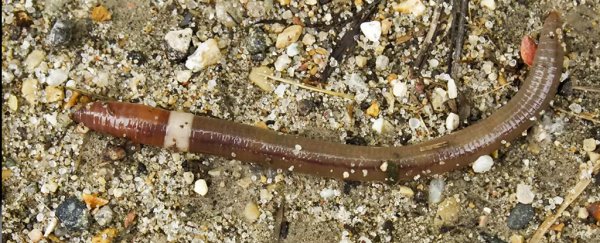Some call them crazy worms. Pick one up, and you'll see why, as the creepy-crawly jerks, writhes and springs out of your hand. (It may even leave its tail behind, as a grim souvenir.) And now, scientists are finding the wrigglers have spread to at least 15 states across the US.
The worms of the genus Amynthas - also known as snake worms, Asian jumping worms and Alabama jumpers, according to Smithsonian Magazine - are a highly invasive lot that first made their way to North America in the 19th century, stowed away on ships carrying plants and dirt.
Since then, they've spread, well, like crazy, and have now been sighted in more than a dozen states, including Minnesota, Wisconsin, Missouri, Illinois, Iowa, Nebraska, Ohio, Texas, Louisiana, Indiana, Kansas, Indiana, Kentucky, Tennessee and Oklahoma, Newsweek.com reported.
They resemble common earthworms, only smaller and brownish in color. However, their reputation is far more sinister. Adult crazy worms reproduce quickly and without mates, laying clutches of eggs the same color as the soil, according to Smithsonian.
Once they hatch, the worms swiftly devour the nutrients in the topsoil around them, leaving behind a loose, grainy mess that resembles coffee grounds.
Related: Bizarre 'worm tornado' in New Jersey has scientists baffled
This nutrient-depleted soil erodes quickly, leaving little sustenance for native plants, or competing species of worms and fungi, Brad Herrick, an ecologist at the University of Wisconsin-Madison, told PBS Wisconsin.
"One thing that we've noticed… is that these earthworms, not only do they change the soil structure and the nutrient dynamics in the soil, but they also somehow or another displace other species of earthworms that are already there," Herrick said.
It's unclear how, exactly, the worms continue to spread across the country. According to a January 2020 article in The Atlantic, scientists think the worms could be hitchhiking from across state borders in imported plants, on the treads of truck tires, by clinging to landscaping equipment or even sailing down waterways (their cocoons can travel surprisingly far in water).
Researchers are still investigating the long-term effects of these highly invasive worms on North America's forests - but, in the short-term, it's clear they're bad news for soil and the native worms that live there.
For now, there's no good way to control their spread in forests that they have already infested, according to Newsweek, but there is some guidance on what to do if you spot one in your garden.
Simply place any adult worms you find in a bag, leave them in the sun for 10 minutes, then throw them away. If, that is, they don't jump out of your hands first.
Related content:
In photos: Worm grows heads and brains of other species
The 10 strangest animal discoveries
Deep-sea creepy crawlies: Images of acorn worms
This article was originally published by Live Science. Read the original article here.
